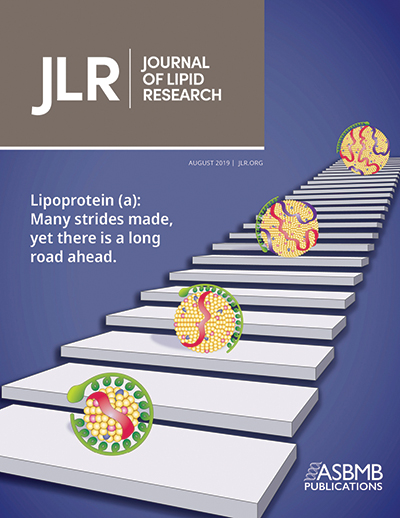JLR: Virtual issue sheds light on a key risk factor for heart disease
Because lipids such as cholesterol and triglycerides are hydrophobic and tend to clump up, rather than dissolve, in water, they need help getting around inside the body. Lipoproteins are complex assemblies with hydrophilic outer shells that package hydrophobic lipids in their core, allowing them to hitch a ride through the bloodstream. These delivery particles play an important role in the absorption of dietary lipids from the small intestine and also transport lipids to and from the liver.
 The cover of the JLR virtual issue depicts the Lp(a) particle following the steps of a walking path, getting bigger as the road stretches into infinity.
The cover of the JLR virtual issue depicts the Lp(a) particle following the steps of a walking path, getting bigger as the road stretches into infinity.
High levels of one particular class of lipoprotein, known as lipoprotein (a), are associated with atherosclerosis, inflammation and thrombosis, but no treatments are available in the clinic that specifically lower Lp(a), and much of what governs Lp(a) assembly is still unknown.
A new from the Journal of Lipid Research titled “Lipoprotein (a): Many strides made, yet there is a long road ahead” explores the past, present and future status of Lp(a) research and showcases researchers pushing this field forward. This issue was assembled by JLR Junior Associate Editor from Columbia University Irving Medical Center in New York City.
Several papers collected in this issue offer insights into how various Lp(a)-reducing drugs work. In one of these studies, and colleagues at the University of California, Davis, and the University of Hong Kong demonstrated that alirocumab — an inhibitor of the lipid-binding enzyme PCSK9 — could lower Lp(a) levels regardless of the isoform of proteins in Lp(a).
A study by and an international team of researchers suggests that another PCSK9 inhibitor, evolocumab, reduces Lp(a) levels partly by increasing the expression of LDL receptors.
Elisa Waldmann and at Ludwig Maximilian University of Munich wrote a review that discusses apheresis as an effective method of selectively clearing Lp(a) from the blood and reducing risk of cardiovascular disease.
Another review, penned by at McGill University, describes the association of Lp(a) with aortic valve disease and outlines steps toward developing much-needed preventive and therapeutic strategies.
Enjoy reading ASBMB Today?
Become a member to receive the print edition four times a year and the digital edition monthly.
Learn moreGet the latest from ASBMB Today
Enter your email address, and weâll send you a weekly email with recent articles, interviews and more.
Latest in Science
Science highlights or most popular articles

How scientists identified a new neuromuscular disease
NIH researchers discover MorimotoâRyuâMalicdan syndrome, after finding shared symptoms and RFC4 gene variants in nine patients, offering hope for faster diagnosis and future treatments.

Unraveling cancerâs spaghetti proteins
MOSAIC scholar Katie Dunleavy investigates how Aurora kinase A shields oncogene c-MYC from degradation, using cutting-edge techniques to uncover new strategies targeting âundruggableâ molecules.

How HCMV hijacks host cells â and beyond
Ileana Cristea, an ASBMB Breakthroughs webinar speaker, presented her research on how viruses reprogram cell structure and metabolism to enhance infection and how these mechanisms might link viral infections to cancer and other diseases.

Understanding the lipid link to gene expression in the nucleus
Ray Blind, an ASBMB Breakthroughs speaker, presented his research on how lipids and sugars in the cell nucleus are involved in signaling and gene expression and how these pathways could be targeted to identify therapeutics for diseases like cancer.

Receptor antagonist reduces age-related bone loss in mice
Receptor antagonist reduces bone loss and promotes osteoblast activity in aging mice, highlighting its potential to treat osteoporosis. Read more about this recent JBC paper.

Engineered fusion protein targets kiwifruit pathogen
Synthetic protein selectively kills kiwifruit pathogen, offering a promising biocontrol strategy for agriculture. Read more about this recent JBC paper.

